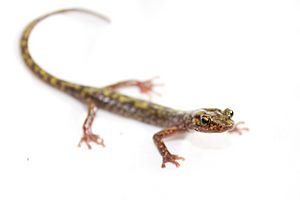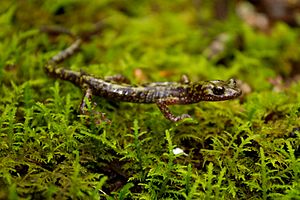Green salamander facts for kids
Quick facts for kids Green salamander |
|
|---|---|
 |
|
| Conservation status | |
| Scientific classification | |
| Synonyms | |
|
The green salamander (Aneides aeneus) is a special type of salamander. It belongs to a family called Plethodontidae. This means it breathes through its skin and the lining of its mouth, not with lungs!
The green salamander and the Hickory Nut Gorge green salamander are the only ones of their kind found in the eastern United States. Other Aneides salamanders live west of the Mississippi River. Green salamanders are rarely seen in nature. They like very specific places: moist, shady cracks in rocks.
Contents
About the Green Salamander
The green salamander is small and quite flat. It has green, moss-like spots on its darker back. This makes it the only salamander in North America with green markings.
It has square-shaped toe tips and big, noticeable eyes. Its belly is light blue to yellow. Adult green salamanders are about 8 to 12 centimeters (3 to 5 inches) long. They have 14 to 15 grooves on their sides.
Scientists used to think Aneides aeneus was the only species of its group in the Eastern United States. But a study in 2019 found that some groups of A. aeneus are actually different. This means there might be a few different species that look very similar. One of these is now known as the Hickory Nut Gorge green salamander.
All eastern species of Aneides are now grouped into a special subgenus called Castaneides. These are the only salamanders in North America with green markings. Because they also live in very specific places, they are easy to spot if you find one.
Where They Live
The green salamander lives in the Alleghenies and Cumberland Plateau. Their home stretches from southwestern Pennsylvania down to northern Alabama and northeastern Mississippi. You can also find them in South-Central Ohio.
Some small groups live in the Blue Ridge Escarpment. This is where Georgia, North Carolina, and South Carolina meet. The main area where they live goes southwest from Fayette County, Pennsylvania. It covers eastern West Virginia, eastern Kentucky, and parts of Virginia, Tennessee, and Alabama. A group found in 1930 in the Great Smoky Mountains National Park has not been seen since.
Life and Habits
The green salamander is very picky about where it lives. This species almost always lives in rock crevices. These are cracks in cliffs or other rocky areas. Most of these cracks are shady, with little sunlight. This shade comes from plants or rocks above the crevice.
Sometimes, green salamanders are seen in trees. But these trees are usually next to rocky cliffs. Or the salamander is found under the tree's bark.
Male green salamanders are very protective of their space. They will fight other salamanders or even predators if they feel threatened. This aggressive behavior is rare in salamanders. Females also show this behavior when they are guarding their eggs. Males might butt, snap, bite, or push with their snout. Females will snap at anything that comes near their eggs.
Annual Life Cycle
Reproduction
- Green salamanders usually start mating in late May or early June. The male goes into the rock crevices and waits for females. When a male and female meet, their courtship begins. The female climbs onto the male's tail. They move in a small circle inside the rock crack.
- After a while, the male leaves a small packet of sperm on the ground. The female then moves over it and picks it up with her body.
- Eggs are laid soon after mating. The female lies on her back inside the rock crevice. She presses her belly against the ceiling. Laying eggs can take 20 to 30 hours. She puts a sticky substance on the rock, then lays one egg.
- A group of eggs, called a clutch, usually has 15 to 25 eggs. The female stays with her eggs, often wrapping her body around them. She guards them until they hatch. If something foreign, like a stick or an insect, comes near, she will attack it. She might even eat the invader.
- Female green salamanders do not eat while they are guarding their eggs. Studies have shown their stomachs are empty during this time. This guarding period usually lasts about 3 months. The eggs hatch in September.
After Hatching
- Green salamander eggs hatch throughout September. These salamanders develop directly. This means they do not have a larval stage like tadpoles. They grow into tiny versions of their parents inside the egg.
- Young green salamanders look like their parents when they hatch. They usually leave the crevice where they were born within two months. After the young hatch, the female is no longer as aggressive. She will not try to stop someone from collecting her young after they have hatched. Newborn green salamanders almost always leave their birth crevice and do not come back.
Hibernation
- Before winter, in November, green salamanders spread out from their breeding crevices. This is when you might see them moving over and between rocks. After this, they are thought to go deep into the cracks of cliffs to hibernate. Hibernation is like a deep sleep during winter. Scientists have tried to find them underground or under logs, but they haven't found any.
Waking Up
- Green salamanders come out of hibernation around May. During this time, they are seen moving around the rock crevices and outcrops. They often do this during light rains at night.
Protecting the Green Salamander
It is hard to protect such a secretive animal. Green salamanders are very specific about their homes. This makes them more vulnerable to habitat destruction. However, the cliffs and rocky areas they choose are usually safe.
It is thought that green salamanders once lived in the old chestnut forests. These forests covered a lot of the Great Smoky Mountains National Park. We don't know if they used trees more or less than their current rock habitats. But it is possible. When they do live in trees, studies show they prefer hardwood trees over pine trees.
Green salamanders have been harmed by losing their homes, climate change, diseases, and too much collection by people. They also grow slowly for salamanders. Some studies say it takes 3 years to become old enough to reproduce. Others say it takes 7 to 8 years.
In Indiana, the green salamander is listed as an endangered species. This means it is at high risk of disappearing forever. They are also listed as "imperiled" in Georgia and North Carolina. In South Carolina, they are "critically imperiled."
See also
 In Spanish: Aneides aeneus para niños
In Spanish: Aneides aeneus para niños



